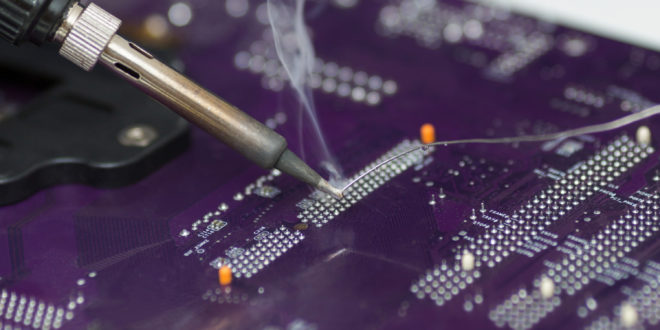Electronics manufacturing adopted the surface-mount technology, commonly known as SMT around 50 years ago. Even though production still heavily relied on through-hole technology (THT) back in time, the advantages of SMT gradually made it the most popular method for printed circuit board assembly (PCBA). In fact, the modern mass production of electronic devices became possible due to SMT.
SMT – what does it mean?
The SMT meaning is hidden in the name of the technology itself. It is mounting the components on the surface of a printed circuit board. The SMT term suggests attaching elements to a PCB without drilling and mechanical bonding.
THT attaches components to a PCB mechanically with manual assistance while the pick-and-place machines used by SMT are moving automatically according to the preprogramed plan locating items on the board surface covered with a soldering paste. The paste is usually made of materials that require the reflow procedure performed in a special oven to create the bonds by high temperatures, nitrogen atmosphere, laser, infrared radiation or vapour.
Steps of SMT process
The process starts with stacking PCBs vertically in a PCB loading machine and moving them to a screen-printer machine, which is used for applying the solder paste on the certain points of the board. Since this step determines the quality of PCBAs, it requires solder paste inspection with In-line SPI devices prior to mounting.
Then, a pick-and-place machine or a component mounter locates all of the elements in their respective places. Thus assembled products move to the reflow oven to solidify the paste permanently attaching components to the PCBs.
SMT: pros and cons
SMT provides original equipment manufacturers (OEMs) and electronics manufacturing service (EMS) providers with the possibility for a fully automated production process starting from component and soldering paste inspection up to mounting, soldering and detecting errors. This makes the manufacturing process cheaper, while also allowing working with way smaller components than the ones used for the production powered by THT. The prices for surface mount devices, also referred to as SMD assembly are lower than the prices of the components required by THT.
While it is definitely possible to save a significant amount of money working with SMT in the long run, setting up such a production line requires a rather large investment. Fortunately, this drawback can be resolved by outsourcing production to EMS providers.
It is also crucial to note SMT has rather costly rework and repair procedures.
Conclusion: SMT meaning for electronics industry
The SMT meaning for the electronics industry is significant as this technology has led to the mass production of electronic devices keeping the manufacturing costs reasonable and allowed effectively minimising the size of electronics making many goods much more compact. Collaboration with an EMS provider allows OEMs to avoid a costly investment into an SMT production line.
Assel is an experienced SMD provider, to find out more about SMD assembly go to: Asselems.com



